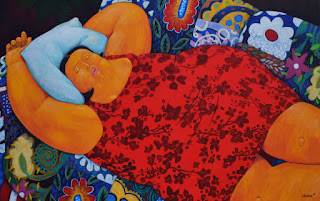2017 Qube Exhibition : Dreamscape
Blue Mountains/ 18x24 in. / acrylic on canvas / 2017
Couch/ 36x60 in. / acrylic on canvas / 2016
From Turqouise to Indigo/ 24x 14 in. / acrylic on canvas / 2017
Ina/ 36x60 in. / acrylic on canvas / 2017
Isabel/ 36x60 in. / acrylic on canvas / 2017
Maskarra/ 36x36 in. / acrylic on canvas / 2017
No Pillow/ 36x36 in. / acrylic on canvas / 2017
Starry Night/ 18x24 in. / acrylic on canvas / 2017
The Black Book/ 36x36 in. / acrylic on canvas / 2017
And Then She Saw Herself/ 36x60 in. / acrylic on canvas / 2016
Dreamscape by Adjani Arumpac
Dreamscape is a collection of paintings conceived during siesta, a Spanish colonial legacy intrinsic in the Philippine culture. “When I was in the corporate world, a siesta was considered The Great Escape. One has to hide somewhere to get that luxurious nap.” Raymond Legaspi graduated from the University of Santo Tomas with a diploma in Advertising. For the next two decades, he worked in the advertising industry-- from being a production artist in 1987 to Executive creative director in 2006. After going through the circuit of seven agencies and garnering numerous creative rewards, he decided to leave it all and go back to Silay, Negros Occidental to pursue full-time painting. Legaspi’s background contextualizes his idyllic representations in oil on canvas, a narrative of the return to rural he has explicitly put in all of his artist statements. As such, his body of work belies the calm it shows. It is a text that must be read through an active gaze employed by an artist resolute in turning away from the Center.
Literally, this series are portraits of sleeping women. Those who are not naked wear the ubiquitous daster, a lightweight clothing usually worn inside the home. But the artist skillfully infuses another disparate element in the domesticity and comfort conveyed by females in various states of repose. He drowns the silence of sleep on the canvas with the noise of a proliferation of hues and patterns—on the daster and on the bedsheets. This noise is central to the artist’s depiction of utopia that defines his creative statement—an exploration of a fictive space of solace from and within he paints his ouvres. The operative word is fiction, and as with the rest of his narrative, it needs unpacking so as to be able to accurately locate the core of Legaspi’s practice.
The space where he chose to retire to and create is Silay, his hometown, a small city dubbed as the cultural center of the so-called Sugar Bowl of the Philippines. Initially a military district of the Spanish colonial government, a rigid encomienda system of farming sugar cane, among others, was established at the turn of the century that brought economic wealth to the province. Silay held one of the largest settlement of the landed affluent families, hence the concentration of arts and culture cultivation in the city. When the sugar industry saw its downfall, and along with it the economic slump of the province, the underprivileged were first to experience backlash—resulting in poverty and hunger; and unrest that led to massacres of and revolutions led by peasants. This is the rich history that indirectly informs and texturizes Legaspi’s notions of the of rural—markedly defined by portrayals of heavy-bodiedness that pertain to both wealth/health, and gluttony.
In the artist’s context, the rural is that which is outside the Metropolis that is Imperial Manila, where he flourished and flailed as a corporate creative and eventually escaped. But, in retrospect, the rural is a misnomer as Silay is decidedly metropolitan. This is where fantasy/fiction as personal identification sets in. The sociopolitical dynamics that defines his utopia—where a system in place has thrived on wages not commensurate to the labor/talent exerted/applied—are of the same blueprint as the Center he left. As such, his paintings are representations of a difference compounded into one surface of paradox—detailed and deconstructed by the patterns that saturate his canvases.
What Legaspi highlights are not portraits of corpulent female bodies—the intimations to intimacy, the private and plump, the relaxed and rural. These are but negatives imprinted on a contemporary metanarrative he knows all too well. Dreamscape, as the title implies, invites the viewer to look at these portraits as landscapes that reveal the horror vacui of a culture and system, where affluence is prime and hence, more is deemed as more. The clashing patterns, multicolored florals and foliage, kitschy and pastiche, intricately painted in bright hues, pervading—all point to a lack that defines and redefines the artist’s valuation of what is rest and unrest, as informed by his forays in the Center. Escape is not a geographical destination nor an end but a repetition of creative process—to create, again and again; to recreate aspirations and hopes fast consumed and disposable; to maintain a semblance of the dream—the only acceptable.











